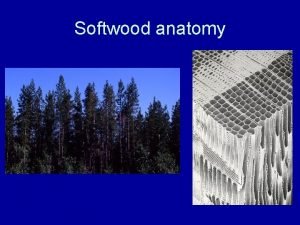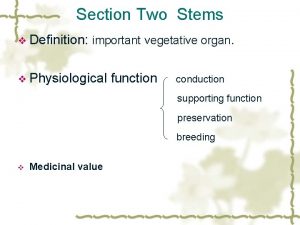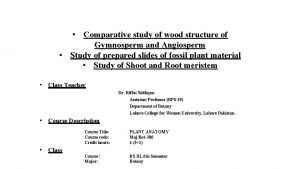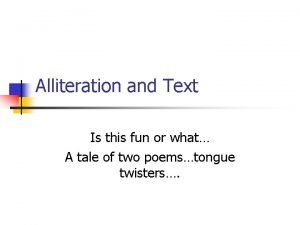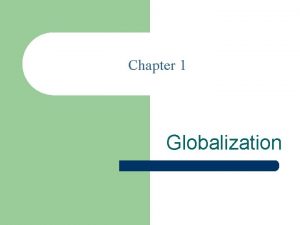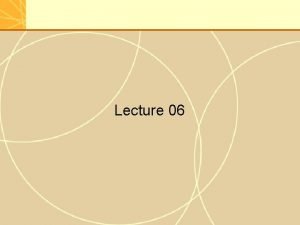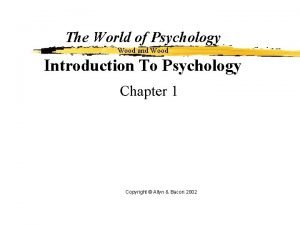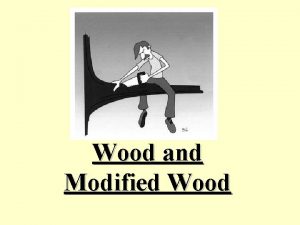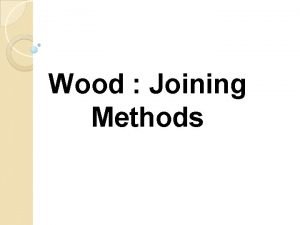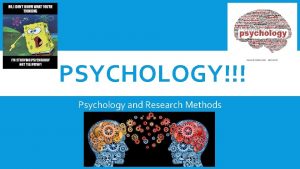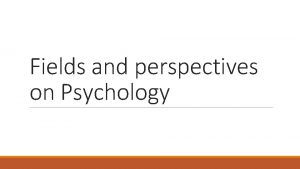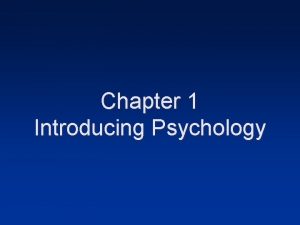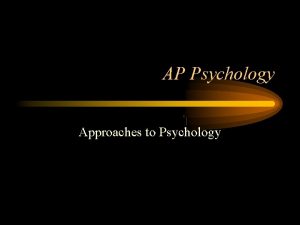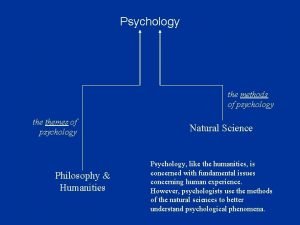The World of Psychology Wood and Wood Learning


























































- Slides: 58

The World of Psychology Wood and Wood Learning Chapter 5 This multimedia product and its contents are protected under copyright law. The following prohibited by law: n any public performance or display, including transmission of any image over a network; n preparation of any derivative work, including the extraction, in whole or in part, of any images; n any rental, lease, or lending of the program

Learning p. When people think about academic Psychology this is usually what they picture. p. A lot of the first “real” scientific Psychology was done on learning. p. Probably the topic that moved Psychology from a branch of Philosophy to a branch of Physical Science. Copyright © Allyn & Bacon 2002

Learning: Modern Definition Learning may be defined as a relatively permanent change in behavior, knowledge, capability, or attitude that is acquired through experience and cannot be attributed to illness, injury, or maturation. Copyright © Allyn & Bacon 2002

Measuring Learning: Problem Statement p. Psychologists cannot observe learning directly but must infer that it has occurred. p. They draw inferences from changes in observable behavior or in measurable capabilities and attitudes. Copyright © Allyn & Bacon 2002

More Learning p. Learning does not always result in an observable change in behavior. * o. Motivation – we “want” to o. Context – Only “fits in” occasionally o. Capability – Requires external conditions * Note difference with textbook Copyright © Allyn & Bacon 2002

1 How do organisms learn? p Through many different avenues. o Habituation o Classical conditioning o Instrumental or operant conditioning o Cognitive learning Copyright © Allyn & Bacon 2002

2 How do organisms learn? We will discuss three basic forms of learning: 1. Classical conditioning 2. Operant conditioning 3. Observational learning (a type of cognitive learning). Copyright © Allyn & Bacon 2002

Classical Conditioning p. Pavlov p. Conditioned Stimulus p. Unconditioned Response p. Conditioned Response DR. IVAN PAVLOV (1849 -1936)

Pavlov C Ivan Pavlov (1849– 1936) C C C organized and directed research in physiology at the Institute of Experimental Medicine in St. Petersburg, Russia from 1891 until his death 45 years later. Conducted experiments on the physiology of digestion He won a Nobel Prize in 1904 First time Nobel Prize won by a Russian. Copyright © Allyn & Bacon 2002

Careful Research p Experimental apparatus eliminated: o Vibration, noise, temperature extremes, odors, drafts p Nothing could influence the animals except the conditioning stimuli to which they were exposed. (Schultz, 1975, pp. 187– 188) p Dogs were isolated inside soundproof cubicles p Dogs were put in harnesses to restrain their movements. p Experimenters were in an adjoining cubicle p Dogs were observed through a one-way mirror. p Dogs were presented with food by remote control, p Other conditioning stimuli also presented by remote control p A tube carried the saliva from the dog’s mouth to a container where it was measured. Copyright © Allyn & Bacon 2002

The Apparatus Copyright © Allyn & Bacon 2002

Definitions Related to Classical Conditioning p Classical conditioning: A learning process through which one stimulus comes to predict the occurrence of another stimulus and to elicit a response similar to or related to the response evoked by that stimulus. p Classical conditioning is sometimes referred to as o respondent conditioning o Pavlovian conditioning p Stimulus (STIM-yu-lus): Any event or object in the environment to which organism responds oplural is stimuli. p Reflex is an involuntary response to a particular stimulus. p Reflexes are made up of both a stimulus and a response. Copyright © Allyn & Bacon 2002

Unconditioned Stimulus Unconditioned means “not learned. ”* p Any stimulus that without learning will automatically cause an unconditioned response is called an unconditioned stimulus (US). p Salivation in response to food is an unconditioned reflex because it is p o o o inborn, automatic, unlearned response to a p Unconditioned reflexes are “built into” NS * Differs from textbook Copyright © Allyn & Bacon 2002

Examples of Unconditioned Stimuli p loud noise p light in eye p puff of air in p touching hot stove startle pupil contraction eye blink hand withdrawal p Is Chinese startle response learned? p Others? Copyright © Allyn & Bacon 2002

Unconditioned Response (UR): A response that is invariably elicited by the unconditioned stimulus without prior learning. Copyright © Allyn & Bacon 2002

Conditioned Reflex/Response Conditioned Reflex: A learned reflex rather than a naturally occurring one. p This terminology is confusing! p I prefer Conditioned Response. Copyright © Allyn & Bacon 2002

Classical Conditioning Cont. Important Terms: ` Extinction ` Spontaneous Recovery ` Generalization ` Discrimination ` Higher-Order Conditioning

Conditioned Stimulus p Conditioned means “learned. ”* p. Any stimulus that comes to elicit a conditioned response through Classical Conditioning is called a conditioned stimulus (US). p. Salivation in response to food is an unconditioned reflex because it is p inborn, p automatic, p unlearned response to a p. Unconditioned reflexes are “built into” NS Copyright © Allyn & Bacon 2002

Classical Conditioning Simplified Pictorial View

Classical Conditioning: the Contemporary View p The Cognitive Perspective: Prediction is the critical element p Biological Predispositions: Their role in classical conditioning

Factors Influencing Classical Conditioning p How reliably the CS predicts the US p The number of pairings of the CS and the US p The intensity of the US p The temporal relationship between the CS and the US

Classical Conditioning: The Diagram Event or Object Organism responds to. Unconditioned S 2 S 1 Reflex Evoked Conditioned S 2 CS R 1 US Si m ila r Event or Object Organism Perceives. Elicited Prediction R 2 CR UR

End 5 a Copyright © Allyn & Bacon 2002

Higher-Order Conditioning p Classical conditioning is not limited to just two procedures: o (1) by the pairing of a conditioned stimulus with an unconditioned stimulus o (2) through generalization. p Classical conditioning can occur in another way: o Higher-order conditioning. p Higher-order conditioning takes place when: o a neutral stimulus is paired with an existing conditioned stimulus o a neutral stimulus becomes associated with an existing conditioned stimulus o a neutral stimulus gains the power to elicit the same conditioned response. p Higher-order conditioning can account for many of the positive and negative feelings toward stimuli that people associate with other people or situations. Copyright © Allyn & Bacon 2002

Important Definitions p spontaneous recovery: The reappearance of an extinguished response (in a weaker form) when an organism is exposed to the original conditioned stimulus following a rest period. p generalization: In classical conditioning, the tendency to make a conditioned response to a stimulus similar to the original conditioned stimulus. p discrimination: The learned ability to distinguish between similar stimuli so that the conditioned response occurs only to the original conditioned stimulus but not to similar stimuli. p higher-order conditioning: Conditioning that occurs when a neutral stimulus is paired with an existing conditioned stimulus, becomes associated with it, and gains the power to elicit the same conditioned response. Copyright © Allyn & Bacon 2002

Watson, Little Albert, and Peter Or Learning to Fear Why we learned to dislike Watson. p In the laboratory, Rayner presented Little Albert with a white rat. p As Albert reached for the rat, Watson struck the steel bar with a hammer just behind Albert’s head. p This procedure was repeated, and Albert “jumped violently, fell forward and began to whimper” (Watson & Rayner, 1920, p. 4). p A week later, Watson continued the experiment, pairing the rat with the loud noise five more times. p Then at the sight of the white rat alone, Albert began to cry. Copyright © Allyn & Bacon 2002

Watson, Little Albert, and Peter Or Learning to Fear Why we learned to dislike Watson. p. When Albert returned to the laboratory 5 days later, the fear had generalized to: oa rabbit osomewhat less, to a dog, a seal coat, Watson’s hair, and a Santa Claus mask. p. After 30 days Albert’s fears were still evident, although less intense. p. Albert moved away still afraid of fuzzy things Copyright © Allyn & Bacon 2002

Other Considerations p. The ideal time between conditioned and unconditioned stimuli is about 1/2 second o varies according to the type of response being conditioned o the nature and intensity of the conditioned stimulus o the nature and intensity of the unconditioned stimulus p. Some studies indicate that the age of the subject may also be a variable affecting the optimal time interval p. If the conditioned stimulus occurs too long before the unconditioned stimulus, an association will not form. p. The one notable exception to this general principle is conditioning of taste aversions. Copyright © Allyn & Bacon 2002

Operant Conditioning p. Thorndike’s Law of Effect p. Reinforcement p. Shaping p. Extinction p. Generalization and Discrimination

Thorndike and the Puzzle Box p. American psychologist Edward Thorndike o. Preceded Pavlov odesigned and conducted experiments to study animal intelligence. oattempted to answer questions about the nature of learning across animal species. oinvestigated trial-and-error learning in cats, dogs, chicks, and monkeys. obest-known experiments placed a hungry cat in a wooden box with slats called a puzzle box. After many trials, the cat learned through trial and error to open the door almost immediately after being placed in the box. Copyright © Allyn & Bacon 2002

Thorndike’s Puzzle Box http: //fates. cns. muskingum. edu/~psych/psycweb/history/thorndike. htm#Theory Copyright © Allyn & Bacon 2002

Thorndike’s law of effect p. The consequence, or effect, of a response will determine whether the tendency to respond in the same way in the future will be strengthened or weakened. p. Responses closely followed by satisfying consequences are more likely to be repeated. p. Connections between a stimulus and a response will be strengthened if the response is followed by a satisfying consequence and weakened if the response is followed by discomfort. Copyright © Allyn & Bacon 2002

Thorndike builds a Foundation p. Thorndike (1898) insisted that it was “unnecessary to invoke reasoning” to explain how the learning took place. p. Thorndike’s law of effect formed the conceptual starting point for B. F. Skinner’s work in operant conditioning. Copyright © Allyn & Bacon 2002

Operant Conditioning p. A type of learning in which the consequences of behavior are manipulated in order to increase or decrease that behavior Copyright © Allyn & Bacon 2002

Operant Vs Classical Conditioning p. In classical conditioning o. Organism does not learn a new response o. O learns to make an old or existing response to a new stimulus. o. O cannot help but respond in expected ways. o. Classically conditioned responses are involuntary or reflexive o. Process begins with stimulus to evoke a reflexive response. p In operant conditioning o. O learns a new response o. O learns to apply voluntary responses. o Response comes first, the consequence that follows tends to modify this response in the future. o. Consequences of behavior manipulated to increase or decrease response frequency or to shape an entirely new response. o. Behavior that is reinforced tends to be repeated. o. Process does not begin with a stimulus to elicit a response. Copyright © Allyn & Bacon 2002

Operant Terms Definitions p. A reinforcer is anything that strengthens or increases the probability of the response it follows. Behavior that is ignored or punished is less likely to be repeated. pshaping: An operant conditioning technique that consists of gradually molding a desired behavior (response) by reinforcing responses that become progressively closer to it. p. Skinner box: A soundproof chamber with a device for delivering food and detecting behavior - usually automatically. Copyright © Allyn & Bacon 2002

Reinforcement One Dichotomy +/- Positive - a reward that follows a response and increases the probability that the response will be repeated. Negative - the termination of an unpleasant stimulus after a response that increases the probability that the response will be repeated.

Reinforcement another Dichotomy Primary - fulfills basic physical need for survival Secondary - NS that becomes reinforcing after repeated pairings with other reinforcers.

Reinforcement Schedules (Partial Reinforcement) Fixed-Ratio - reinforcer is given after a fixed number of correct responses Variable-Ratio - reinforcer is given after a variable number of correct responses Fixed-Interval - reinforcer is give after first correct response after passage of fixed interval of time Variable-Interval - reinforcer is given after first correct response following a variable interval of time

Reinforcement Schedules http: //www. fiu. edu/orgs/psych/eab_3002/interact/schedule. htm

Shaping Just a Bit at a Time p. B. F. Skinner developed this technique p. Particularly effective in conditioning complex behaviors. p. Process: o Don’t wait for desired response and then reinforcing it o Reinforce any movement in the direction of desired response o Gradually guide responses closer and closer to the goal. Copyright © Allyn & Bacon 2002

The Textbook’s Skinner Box Bull Skinner designed a soundproof apparatus, commonly called a Skinner box, with which he conducted his experiments in operant conditioning. One type of box is equipped with a lever, or bar, that a rat presses to gain a reward of food pellets or water from a dispenser. A record of the animal’s bar-pressing is registered on a device called a cumulative recorder, also invented by Skinner. Through the use of shaping, a rat in a Skinner box is conditioned to press a bar for rewards. It may be rewarded first for simply turning toward the bar. The next reward comes only when the rat moves closer to the bar. Each step closer to the bar is rewarded. Next the rat must touch the bar to receive a reward; finally, it is rewarded only when it presses the bar. Copyright © Allyn & Bacon 2002

Skinner Box http: //www. biozentrum. uni-wuerzburg. de/genetics/behavior/learning/Skinner. Box. html Click for German Skinner Box Photos http: //www. nici. kun. nl/~voogd/skinner/index. html Copyright © Allyn & Bacon 2002

Skinner’s Version One pleasant Saturday afternoon I surveyed my supply of dry pellets and, appealing to certain elemental theorems in arithmetic, deduced that unless I spent the rest of that afternoon and evening at the pill machine, the supply would be exhausted by ten-thirty Monday morning. Since I do not wish to deprecate the hypothetico-deductive method, I am glad to testify here to its usefulness. It led me to apply our second principle of unformalized scientific method and to ask myself why every press of the lever had to be reinforced. I was not then aware of what had happened at the Brown Laboratories, as Harold Schlosberg later told the story. A graduate student had been given the task of running a cat through a difficult discrimination experiment. One Sunday, the student found the supply of cat food exhausted. The stores were closed, and so, with a beautiful faith in the frequency-theory of learning, he ran the cat as usual and took it back to its living cage unrewarded. Schlosberg reports that the cat howled its protest continuously for nearly forty eight hours. Unaware of this, I decided to reinforce a response only once every minute and to allow all other responses to go unreinforced There were two results: (a) my supply of pellets lasted almost indefinitely, and (b) each rat stabilized at a fairly constant rate of responding. Now, a steady state was something I was familiar with from physical chemistry, and I therefore embarked upon the study of periodic reinforcement. I soon found that the constant rate at which the rat stabilized depended upon how hungry it was. Hungry rat, high rate; less hungry rat, lower rate. At that time I was bothered by the practical problem of controlling food deprivation. I was working half time at the Medical School (on chronaxie of subordinations) and could not maintain a good schedule in working with the rats. The rate of responding under periodic reinforcement suggested a scheme for keeping a rat at a constant level of deprivation. The argument went like this: Suppose you reinforce the rat, not at the end of a given period, but when it has completed the number of responses ordinarily emitted in that period. And suppose you use substantial pellets of food and give the rat continuous access to the lever. Except for periods when the rat sleeps, it should operate the lever at a constant rate around the clock. For, whenever it grows hungrier, it will work faster, get food faster, and become less hungry, while whenever it grows slightly less hungry, it will respond at a lower rate, get less food, and grow hungrier. By setting the reinforcement at a given number of responses, it should even be possible to hold the rat at any given level of deprivation. I visualized a machine with a dial which one could set to make available, at any time of day or night, a rat in a given state of deprivation. Of course, nothing of the sort happens. This is fixed-ratio rather than fixed- interval' reinforcement and, as I soon found out, it produces a very different type of performance. This is an example of a fifth unformalized principle of scientific c practice, but one which has at least been named. Walter Cannon described it with a word invented by Horace Walpole: serendipity the art of finding one thing while looking for something else. Copyright © Allyn & Bacon 2002

Superstitious Behavior p. Sometimes a reward follows a response but the two are not related. p. Superstitious behavior occurs if an individual falsely “believes” that a connection exists between an act and its consequences. Copyright © Allyn & Bacon 2002

Extinction p. Responses followed by reinforcers tend to be repeated and responses no longer followed by reinforcers will occur less and less frequently and eventually die out. p. In operant conditioning, extinction occurs when reinforcers are withheld. p. Spontaneous recovery also occurs in operant conditioning. Copyright © Allyn & Bacon 2002

Generalization and Discrimination p. Generalization occurs in operant conditioning. p. Generalization occurs when a reinforced stimuli causes response to non reinforced stimuli which have common characteristics. p. Discrimination in operant conditioning involves learning to distinguish between a stimulus that has been reinforced and other stimuli that may be very similar. p. Discrimination is learned when the response to the original stimulus is reinforced but responses to similar stimuli are not reinforced. Copyright © Allyn & Bacon 2002

Factors Influencing Operant Conditioning p. The magnitude of reinforcement p. The immediacy of reinforcement p. The level of motivation of the learner

Other Issues in Operant Conditioning Punishment W Escape Learning W Avoidance Learning W Learned Helplessness W Biofeedback W Behavior Modification W

Comparison Copyright © Allyn & Bacon 2002

Cognitive Learning p. Insight p. Latent Learning p. Cognitive Maps p. Observational Learning o Learning Aggression

Post Pavlov and Skinner p. A growing number of psychologists ostress the role of mental processes. o broaden the study of learning to include such cognitive processes as: ythinking, yknowing, yproblem solving, yremembering, y forming mental representations. p. According to cognitive theorists, these processes are critically important in a more complete, more comprehensive view of learning. Copyright © Allyn & Bacon 2002

Insight The sudden realization of the relationship between elements in a problem situation, which makes the solution apparent. http: //sun. science. wayne. edu/~wpoff/cor/mem/cogninst. html http: //www. ship. edu/~cgboeree/insight. html (Gestalt View of Insight) Copyright © Allyn & Bacon 2002

Latent Learning that occurs without apparent reinforcement but that is not demonstrated until sufficient reinforcement is provided. http: //website. lineone. net/~nene/learning. htm http: //sun. science. wayne. edu/~wpoff/cor/mem/cognlatn. html A NEW FORMULA FOR BEHAVIORISM [1] Edward Chace Tolman (1922) First published in Psychological Review, 29, 44 -53. Copyright © Allyn & Bacon 2002

Cognitive Maps A mental representation of a spatial arrangement such as a maze. http: //www. cogs. susx. ac. uk/lab/nlp/gazdar/teach/atc/1999/web/verenah/ http: //www. alleydog. com/cognotes/cogmap. html http: //www. people. memphis. edu/~kshawes/cogmap/1 COGNITIVE MAPS IN RATS AND MEN[1] Edward C. Tolman (1948) First published in The Psychological Review, 55(4), 189 -208. Copyright © Allyn & Bacon 2002

Observational Learning p. Learning by observing the behavior of others and the consequences of that behavior; learning by imitation. p. Another name for observational learning: modeling p. Also called Social Learning Theory p. Occurs when an observer's behavior changes after viewing the behavior of a model. http: //www. funderstanding. com/observational_learning. cfm http: //mentalhelp. net/psyhelp/chap 4 g. htm Copyright © Allyn & Bacon 2002

Observational Learning 2 p. Model: The individual who demonstrates a behavior or serves as an example in observational learning. p. Note: Models may also be physical constructs that demonstrate a behavior, process, method, or result. Copyright © Allyn & Bacon 2002

End Chapter 5 Copyright © Allyn & Bacon 2002
 Softwood anatomy
Softwood anatomy Xylem
Xylem Cuadro comparativo e-learning m-learning b-learning
Cuadro comparativo e-learning m-learning b-learning Gymnosperm structure
Gymnosperm structure Esau wood poem
Esau wood poem Wood wood teenager
Wood wood teenager Hình ảnh bộ gõ cơ thể búng tay
Hình ảnh bộ gõ cơ thể búng tay Bổ thể
Bổ thể Tỉ lệ cơ thể trẻ em
Tỉ lệ cơ thể trẻ em Voi kéo gỗ như thế nào
Voi kéo gỗ như thế nào Tư thế worm breton
Tư thế worm breton Bài hát chúa yêu trần thế alleluia
Bài hát chúa yêu trần thế alleluia Các môn thể thao bắt đầu bằng tiếng đua
Các môn thể thao bắt đầu bằng tiếng đua Thế nào là hệ số cao nhất
Thế nào là hệ số cao nhất Các châu lục và đại dương trên thế giới
Các châu lục và đại dương trên thế giới Cong thức tính động năng
Cong thức tính động năng Trời xanh đây là của chúng ta thể thơ
Trời xanh đây là của chúng ta thể thơ Mật thư tọa độ 5x5
Mật thư tọa độ 5x5 Làm thế nào để 102-1=99
Làm thế nào để 102-1=99 Phản ứng thế ankan
Phản ứng thế ankan Các châu lục và đại dương trên thế giới
Các châu lục và đại dương trên thế giới Thể thơ truyền thống
Thể thơ truyền thống Quá trình desamine hóa có thể tạo ra
Quá trình desamine hóa có thể tạo ra Một số thể thơ truyền thống
Một số thể thơ truyền thống Cái miệng nó xinh thế
Cái miệng nó xinh thế Vẽ hình chiếu vuông góc của vật thể sau
Vẽ hình chiếu vuông góc của vật thể sau Thế nào là sự mỏi cơ
Thế nào là sự mỏi cơ đặc điểm cơ thể của người tối cổ
đặc điểm cơ thể của người tối cổ Thế nào là giọng cùng tên?
Thế nào là giọng cùng tên? Vẽ hình chiếu đứng bằng cạnh của vật thể
Vẽ hình chiếu đứng bằng cạnh của vật thể Fecboak
Fecboak Thẻ vin
Thẻ vin đại từ thay thế
đại từ thay thế điện thế nghỉ
điện thế nghỉ Tư thế ngồi viết
Tư thế ngồi viết Diễn thế sinh thái là
Diễn thế sinh thái là Dot
Dot Thế nào là số nguyên tố
Thế nào là số nguyên tố Tư thế ngồi viết
Tư thế ngồi viết Lời thề hippocrates
Lời thề hippocrates Thiếu nhi thế giới liên hoan
Thiếu nhi thế giới liên hoan ưu thế lai là gì
ưu thế lai là gì Sự nuôi và dạy con của hổ
Sự nuôi và dạy con của hổ Khi nào hổ mẹ dạy hổ con săn mồi
Khi nào hổ mẹ dạy hổ con săn mồi Hệ hô hấp
Hệ hô hấp Từ ngữ thể hiện lòng nhân hậu
Từ ngữ thể hiện lòng nhân hậu Thế nào là mạng điện lắp đặt kiểu nổi
Thế nào là mạng điện lắp đặt kiểu nổi Positive psychology ap psychology definition
Positive psychology ap psychology definition Social psychology chapter 13
Social psychology chapter 13 Fundamental attribution error ap psychology
Fundamental attribution error ap psychology Introspection method in psychology
Introspection method in psychology Social psychology is the scientific study of:
Social psychology is the scientific study of: Health psychology definition ap psychology
Health psychology definition ap psychology Ap world history chapter 25 africa and the atlantic world
Ap world history chapter 25 africa and the atlantic world The changing world output and world trade picture
The changing world output and world trade picture The changing world output and world trade picture
The changing world output and world trade picture Inductive and analytical learning
Inductive and analytical learning Inductive and analytical learning problem
Inductive and analytical learning problem
